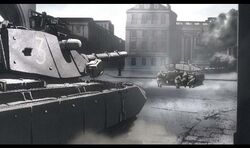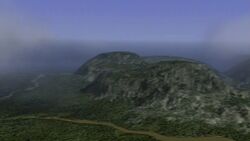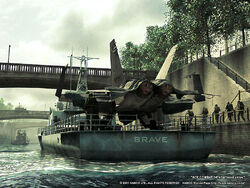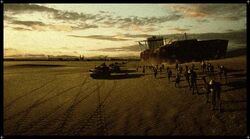The ISAF Army is the land-based branch of the Independent State Allied Forces' military. As part of the coalition forces, the ISAF Army was composed of infantry, combat vehicles, weaponry and artillery contributed by the ISAF member states. It also features a marine landing force supported by the ISAF Navy. The ISAF Army would suffer considerable casualties during the Continental War.[1]
History[]
Early engagements[]

ISAF Tanks retreating
In the wake of Erusea's invasion of San Salvacion and Stonehenge in August 2003, the nations of the Central Usea Treaty Organization reformed into the ISAF and combined their military forces to counterbalance the Eruseans' technologically advanced army. However, the Eruseans' blitz offensive caught the ISAF off-guard, and the loss of air support resulting from Stonehenge's use as an anti-aircraft weapon left the ISAF Army at a disadvantage; heavy losses were incurred during its defeats and subsequent retreat to the east.[2] By mid-2004, survivors of the Erusean onslaught began gathering at the northern port of Saint Ark and prepared to evacuate the Usean mainland.[3]
Evacuating the mainland[]
In October 2004, the ISAF Army boarded ISAF Navy vessels and crossed the Gulf of St. Ark bound for North Point. This evacuation would be the largest single mobilization of ISAF troops up until that point in the war. The ISAF Army reestablished ISAF's General Headquarters at North Point and, in conjunction with the ISAF Air Force, began setting up defenses around the island nation. For the rest of 2004, the air force would move to the forefront against Erusea, while the army regrouped and completed battle preparations for a mainland counteroffensive.[1]
ISAF counteroffensive[]
Beginning in January 2005, the ISAF Army would play a central role in the ISAF's efforts to reclaim the mainland from Erusean control. The amphibious landings of Operation Bunker Shot would be the first combat action the ISAF Army had seen since the evacuation more than two months earlier. Supported by long-range artillery fire and fighter aircraft launched from ISAF Navy vessels, the amphibious landing units stormed the Caranda, Crowne and Halle beaches in southern Usea. Despite intense resistance from the coastal defenses, including the appearance of several Erusean A-10 attack planes, the mission was a success, and the ISAF Army quickly established a beachhead.[4]

ISAF's southern stronghold, Istas Fortress.
The ISAF's next goal was to retake its former Istas Fortress facility in the southernmost foothills of the Lambert Mountains, east of the Chopinburg Rainforest. ISAF Air Force squadrons penetrated Stonehenge's attack range and dealt a considerable blow to the Erusean occupation forces. This victory weakened the fortress's defensive power and gave the ISAF ground forces an advantage when they later assaulted and recaptured the facility. By recapturing Istas Fortress, Erusea's defensive line in central Usea—known as the "Tango Line"—collapsed, allowing the ISAF Army to circumvent the Eruseans and make a quick push towards Los Canas. ISAF ground forces would liberate the city soon after.[5]
In the wake of the Air Forces' stunning destruction of Stonehenge, the ISAF Army advanced on all fronts, steadily pushing the Erusean resistance westward. In July 2005, the ISAF Army and Navy launched a joint landing operation in the Ice Creek region of northern Usea. The Eruseans responded by launching a barrage of cruise missiles at the landing forces and naval vessels. ISAF ace Mobius 1 intercepted the missiles and the invasion force secured the northern part of the continent. Over the coming weeks, the northern divisions would advance to the south and east as the southern divisions pushed northward.[6]
By July, the ISAF's northern divisions had reached the Erusean-occupied capital of San Salvacion. In preparation for the city's liberation, ISAF intelligence coordinated with the local resistance to end the capital's mandatory blackouts. At 0000hrs precisely, the city's lights illuminated the streets and ISAF ground forces stormed the capital. The tank battalions and infantry units were faced with intense urban warfare, close-quarters combat and mined roadways. Once again supported by ISAF fighter squadrons, however, the ISAF tank battalions gained the upper hand and swept the Erusean forces out of the city. Throughout the night and into the morning, ISAF ground patrols and resistance members rounded up the remaining Erusean soldiers still in the city.[7][8]
Ending the war[]

ISAF soldiers advancing alongside naval vessels

ISAF soldiers advancing in Whiskey Corridor
The ISAF Army would be at the forefront of the final two engagements of the war. On August 15, 2005, the ISAF Army and Air Force confronted the Eruseans' final line of defense in the Whiskey Corridor between Amber and Lambert Mountains. ISAF tank battalions advanced their way through the sandy desert terrain and with close air support from ISAF fighter squadrons, flanked the Eruseans' field HQ. Suffering heavy losses, the Erusean forces retreated to their capital, Farbanti, and the ISAF Army broke through Erusea's final line of defense.[9] It would proceed to march to the northeast until it held outside the Erusean capital.
On September 19, 2005, in a three-pronged strike, ISAF laid siege to the Erusean capital. ISAF Navy vessels bombarded the city with long-range artillery fire and deployed the army's amphibious landing teams to secure positions along the coastline. ISAF fighters launched from the carriers supported the landing teams and tank battalions, which had merged with other ISAF ground units entering the city from the east. Bolstered by close air support from ISAF fighters, the ground units overwhelmed the Eruseans' remaining defensive positions and captured their GHQ. ISAF Army units would later discover the body of the Erusean Supreme Commander and his surviving family in one of the helicopters that failed to takeoff near the end of the siege. Following the decisive victory, ISAF ground forces broadcast orders for the immediate surrender of Erusea's remaining forces; the war had come to an end.[10]
After the dissolution of ISAF after the war,[11] its army units returned to their home countries. However, as with the Air Force, some later joined the IUN.[12]
Units[]
- Tank battalions[9][10][13]
- Bravo Team
- Charlie Team
- Oscar Team
- Tango Team
- Marine units[4]
- 32nd Marine Corps Regiment[14]
- Units A and D (Caranda Beach)
- Units B, R, S and T (Crowne Beach)
- Units C, O, P, Q and Y (Halle Beach)
- 32nd Marine Corps Regiment[14]
- 32nd Army Division[15]
Vehicles[]
Known Small Arms[]
References[]
- ↑ 1.0 1.1 Ace Combat 04: Shattered Skies.
- ↑ Interlude 01, Ace Combat 04: Shattered Skies.
- ↑ The Northern Eye, Ace Combat 04: Shattered Skies.
- ↑ 4.0 4.1 4.2 4.3 Operation Bunker Shot, Ace Combat 04: Shattered Skies.
- ↑ Tango Line, Ace Combat 04: Shattered Skies.
- ↑ Breaking Arrows, Ace Combat 04: Shattered Skies.
- ↑ Emancipation, Ace Combat 04: Shattered Skies.
- ↑ 8.0 8.1 Interlude 10, Ace Combat 04: Shattered Skies.
- ↑ 9.0 9.1 Whiskey Corridor, Ace Combat 04: Shattered Skies.
- ↑ 10.0 10.1 Siege of Farbanti, Ace Combat 04: Shattered Skies.
- ↑ "Made in Usea", Usea Reconstruction: Space Elevator Nearing Completion. Our Science. Retrieved January 19, 2019.
- ↑ VR Mode, Ace Combat 7: Skies Unknown
- ↑ Megalith (mission), Ace Combat 04: Shattered Skies.
- ↑ Ace Combat 04: Shattered Skies - Official Guide Book, page 16.
- ↑ page 120, Aces at War: A History.
